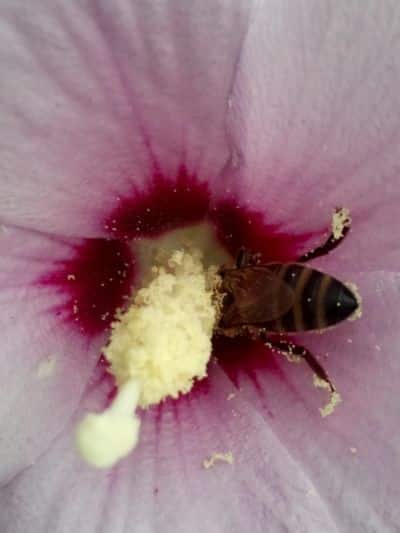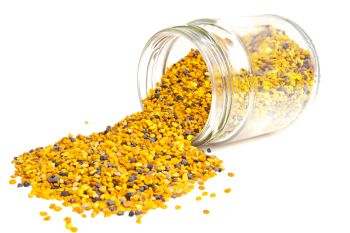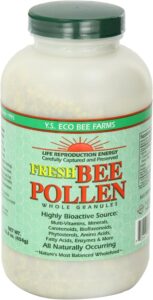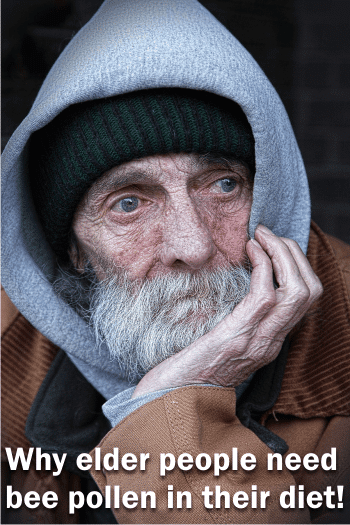TL;DR: Bee pollen’s composition varies by flower but typically includes 10-40% proteins, 13-55% carbs, essential vitamins (B-complex, C, E), and powerful antioxidants like quercetin for everyday vitality.
- Proteins & Aminos: All 9 essentials, up to 40g/100g for muscle and energy support.
- Vitamins & Minerals: Full B-vitamins, beta-carotene (1-20mg), potassium (400-2000mg).
- Antioxidants: Flavonoids and carotenoids fight daily stress; highest in types like chestnut.
- Storage Tip: Freeze fresh at -20°C to preserve enzymes; dry under 30°C to keep nutrients intact.
Bee pollen composition has been studied for decades, and scientists have reached relevant conclusions, including big differences among each pollen type.
The differences are also given by the way bee pollen is stored and processed. There are more than 200 substances present in bee pollen.
To collect bee pollen, beekeepers place traps inside the hive, and when bees arrive with their loads of pollen attached to the hind legs, they must force their way through. Because of the trap’s small size, the bees lose part of the pollen baskets, which fall into special containers.
There are different types of pollen traps: outlet, bottom-board, slice, and top-frame ones in which there are perforated screens or grids with small holes of about 5 mm.
What is bee pollen?
Bee pollen is basically flower pollen mixed with bee saliva. But as simplistic and trivial this may sound, the quality of bee pollen have been recognized since the old Egyptians, Greeks, Arabs and it is mentioned even in the Bible.
Fresh bee pollen

This humidity makes an ideal culture medium for micro-organisms like bacteria and yeast. Which is why beekeepers have to collect it daily and immediately place it into the freezer. This fresh bee pollen is the one with the most nutritional and therapeutic value and when talking about bee pollen composition, we are referring to this type of bee pollen.
Freezing, followed by storage at -20ºC in pure nitrogen, guarantees high biological qualities of bee pollen. Pollen stored for more than 6 months should, however, be dried by lyophilization and stored at -20ºC in pure nitrogen to preserve its highest biological activities.
Conclusion: frozen fresh bee pollen stored in glass jars for one or more years still results in decrease of antioxidant activity. The best way of preserving the quality of fresh bee pollen is to pack it in vacuum or under nitrogen (N2), thus preserving its biological and nutritive properties.
Dried bee pollen
After thawing, bee pollen can be kept only for a few hours and should be further processed as soon as possible to prevent spoilage and preserve its maximum quality. After drying, the water content should be of about 6 g water per 100 g pollen.
There are 2 methods of drying bee pollen: oven drying and freeze drying.
1. The drying should be done in electric ovens, where humidity can continuously escape. The maximum temperature recommended is 30º C, not at 40º C as it is used today. (according to SZCZESNA, T et al., 1995)
2. Freeze drying, also known as lyophilisation, lyophilization, or cryodesiccationis, is done in special machines and represents a better alternative to heated pollen. During this process, the pollen is frozen and then the surrounding pressure is reduced to allow the frozen water to sublime directly from the solid phase to the gas phase.
Yet, the effects on pollen quality have not been tested. It was only proven that it decreased the content of Vitamin C and Provitamin A. (wikipedia on the process of freeze-drying)
The bee pollen that went the process of lyophilisation or freeze-drying, may be stored at room temperature without refrigeration, and it will be protected against spoilage for many years.
Preservation is possible because the greatly reduced water content inhibits the action of microorganisms and enzymes that would normally spoil or degrade the substance.
The quality of dried pollen is below that of fresh pollen. Besides, after a year of keeping it at room temperature while there was no loss of vit C, there were considerable losses of Vit E and beta-carotenes by 15 to 20 %. (According to the Brasilian study “Stability of antioxidant vitamins in bee pollen samples” conducted by DE MELO PEREIRA et al. in 2010.)
Other studies showed that there are loses of considerable amount of its antioxidant activity (about 59%) after one year. (M Campos, 2003)
Bee pollen composition
Main constituents: water, carbohydrates, proteins and amino acids, fats, and fibers. Also possible contaminants.
Minor constituents: minerals and trace elements, vitamins and carotenoids, flavonoids, sterols and terpenes.
Before reviewing these constituents, we have to raise awareness about the dangers of using herbicides to increase crop production. Roundup is especially dangerous as it contains glyphosate, which is a non-selective herbicide, that can harm both unwanted weeds and desirable plants alike. Numerous studies have linked it to cancer and other health problems (read more on Glyphosate: Health Concerns and Safer Alternatives)
There are countries that have banned it, but not all of them.
That is why, unfortunately, bee pollen can be compromised by this dangerous substance.
Always buy organic bee pollen, even if a little more expensive. It’s worth the money.
1. Main components of bee pollen
Water
Fresh bee pollen can have 20% to 30% water.
Fried bee pollen has a maximum allowed humidity, depending on the country: Brazil, 4%, Switzerland, 6%, in Russia: 8-10%, Bulgaria: 10%.
More than 10% makes the pollen susceptible to fermentation.
Less than 6% makes the pollen too dry and less acceptable from a sensory point of view.
Carbohydrates
Fructose, glucose, sucrose, fibers. Generally the carbohydrate content depends on the botanical origin of pollen and is determined by calculation, as the total carbohydrate content cannot be determined easily: 100 less the sum of water, fat, protein and ash content.
Carbohydrates in bee pollen range from 13 to 55 g per 100 g pollen. The recommended daily intake is of 320 g.
The carbohydrates are mainly polysaccharides like starch and cell wall material. The sugars fructose, glucose and sucrose comprise about 90% of all low molecular sugars.
Here are the usual types of sugars found in bee pollen, according to the article published in February 2022, in The Journal of Agricultural and Food Chemistry:
glucose: 2.77−28.49 (g/100g pollen)
fructose: 4.90−33.48 (g/100g pollen)
sucrose: 0.05−9.02 (g/100g pollen)
maltose: 0.16−6.03 (g/100g pollen)
isomaltose: 0.10−0.60 (g/100g pollen)
raffinose: 0.10−0.20 (g/100g pollen)
trehalose: 0.10−0.40 (g/100g pollen)
erlose: 0.10−0.30 (g/100g pollen)
Crude fiber
There could be high variations in the crude fiber content, due to botanical origin and determination method. Usually from 0.3 to 20 g per 100 g pollen. For example, in Switzerland the crude fiber content was reported to be between 10 and 13 g/ in different commercial pollen. In France the values are between 9.2 and 14.4 g/100 g.
The crude fiber content should be reported on each label.
Proteins
10 – 40 g per 100 g bee pollen.
Only about 1/10 of the total protein comes from free amino acids, pollen contains all essential amino acids. However, while the protein content depends strongly on the botanical origin of honey, the qualitative pattern of the amino acids is similar in different types of pollen. Here are the most important essential amino acids in bee pollen:
Threonine
Valine
Methionine
Isoleucine
Leucine
Phenylalanine
Lysine
Tryptophane
Histidine
The recommended daily intake of essential amino acids is of 5845. This is most of the time covered completely by bee pollen. For example, the total content in chestnut is 5590, in willow is 5710, in heather is 5710, in poppy is 7924. Per 100 g pollen.
Fats
1 – 13 g per 100 g pollen
The fat content and composition differ a lot on the botanical origin. There are:
– polar and neutral fats (mono-, di and triglycerides), in bigger amounts,
– fatty acids, sterols and hydrocarbons (terpenes), in smaller amounts.
The main saturated acids are C14, C16 and C18 acids: myristic, palmitic and stearic acids.
The main unsaturated acids are : oleic, linoleic (omega 6) and alpha-linolenic (omega 3). Alpha-linolenic acid has many beneficial effects in nutrition and its concentration in bee pollen varies widely, lying between 0.1 and 4 g /100 g.
MANNING, R (2001) reports in a review that 70 to 90 % of the lipids are composed of fatty acids. As a rule, bee pollen has a higher amount of unsaturated acids, with some exceptions such as sunflower pollen.
In a study from 1974, conducted by STANLEY, R G et al., 3 % of the total lipids are free fatty acid and about half of them are the unsaturated acids oleic, linoleic (omega-6) and linolenic (omega-3).
TIKHONOV, A I; (2006) reports the same amount, like 50-60% of fatty acids are unsaturated acids. And from these unsaturated acids, 70% are oleic, linoleic (Omega 6) and ∝-linolenic (Omega 3) acids. (from mixed pollen from different geographic origins).
Essential amino acids (our body cannot synthesize them, and must be ingested in our diet) found in bee pollen:
Threonine
Valine
Methionine
Isoleucine
Leucine
Phenylalanine
Lysine
Tryptophane
Cystine
2. Minor components of bee pollen
Minerals and trace elements
The mineral content of bee pollen can vary according to its botanical origin and geographic area. Thus, the pollen gathered in spring is different from the one gathered in late summer. There have been recorder differences in potassium, magnesium, calcium, manganese and iron, while the zinc and copper content of pollen appeared to be more constant (HERBERT, E W, 1987).
Potassium (K): 400 – 2000 mg per 100 g pollen
Phosphor (P): 80 – 600 mg per 100 g pollen
Calcium (Ca): 20 – 300 mg per 100 g pollen
Magnesium (Mg): 20 – 300 mg per 100 g pollen
Zink (Zn): 3 – 25 mg per 100 g pollen
Manganese (Mn): 2 – 11 mg per 100 g pollen
Iron (Fe): 1.1 – 17 mg per 100 g pollen
Copper (Cu): 0.2 – 1.6 mg per 100 g pollen
Selenium (Se): 0.05-0.005 mg per 100 g pollen.
Vitamins
Compared to the vitamin-richest corns, fruits and vegetables, pollen has 20 times more vitamine A and significantly more panthothenic and folic acids and biotin.
Values are in mg per 100 g pollen.
· 
· Vitamin E (Tocopherol): 4 – 32
· Vitamin B3 (Niacin): 4 – 14.4
· Vitamin B6 (Pyridoxin): 0.2 – 0.7
· Vitamin B1 (Thiamin): 0.6 – 1.3
· Vitamin B2 (Riboflavin): 0.6 – 2.6
· Vitamin B5 (Pantothenic acid): 0.5 – 2
· Vitamin B9 (Folic acid): 0.3 – 1
· Vitamin B7 (Biotin): 0.05 – 0.07
· Unconjugated vitamin D and its metabolites were investigated in the pollen of Pinus nigra Ar. and Pinus sylvestris
L. It was found that vitamin D (D2, D3) was present in the pollen in amounts about 2 micrograms/10 g and 25-
OHD3, 24,25-dihydroxycholecalciferol [24,25-(OH)2D3] and 1,25-dihydroxycholecalciferol [1,25-(OH)2D3]
between 0.1 and 3 micrograms/10 g of pollen, dependent on pollen species and method (SADEN-KREHULA, M; TAJIC, M, 1987)
· Coenzym Q was detected in pollen from China in quantities from 0 to 193 mg/kg (XUE, X, 2012).
· Provitamin A (b-Carotin): 1 – 20 Represents an antioxidant with powerful antiprostatis and anti prostate cancer activity. β-carotene represents about 17 % of the totals carotenoids. There are differences according to the botanical source. Thus French Cistus pollen contains 20 times more carotenoids than chestnut one (PERCIE DU SERT, 2009).
Lycopene is a very important carotene, also with antiprostatis activity.
Polyphenolics include flavonoids, leukotrienes, catechins, and phenolic acids.
total phenolic content (mg of GAE/g): 0.69−213.00
total flavonoid content (mg of QE/g): 1.82−107.00
Flavonoids

Theses are the compounds that give color and taste to pollen. They can be colorless, yellow, red and purple. And they are the ones that give the bitter taste of pollen.
Most flavonoids exist as glycosides, called aglycones, i.e. sugar derivatives. The amount can vary a lot, between 1293 and 8243 mg/100 g, or, in another study, between 530 and 3258 mg/100 g according to the different pollen types.
Quercetin is one of the main flavonoids in bee pollen. This compound shows in vitro a permanent inhibition of androgen-independents cancer cells PC-3 at the dose of 100 μM.
In prostate cancer cells this activity is due to the ability of quercetin to block the cell cycle in various phases through an inhibition of the expression of several specific genes.
Quercetin also upregulates the expression of various tumour suppressor genes while down-regulating oncogene expression.
In a prospective, double blind, placebo-controlled trial, the patients who had been taking quercetin (500mg, 2 time/day for 4 weeks) showed a significant improvement in NIH chronic prostatitis symptoms, 67% of the patients taking quercetin having a significant decrease of symptoms (SHOSKES, D A (2002) Phytotherapy in chronic prostatitis).
Rutin, a principal pollen constituent, has similar antitumor activity as quercetin. These two substances have been recognised to act against apoptosis (programmed cell death) and thus delay cancer growth (KHAN, N; AFAQ, F; MIKHTAR, H (2006) Apoptosis by dietary factors: the suicide solution for delaying cancer growtth.)
Kaempferol, another bee pollen flavonoid caused a reversible inhibition of PC-3 cancer cells growth (HARI, k, 2004)
Apigenin and other flavonoids present in bee pollen are able to depress kinase activation in prostate cancer (LEPLEY, D M, 2008).
Phytosterols and terpenes
Pollen contains also 0.1 – 0.4 % sterols and 0.1 to 0.2 % mono-terpenes. It is considered that plant sterols have a cholesterol-lowering effects in humans.
Here are the main sterols present in bee pollen:
beta-estradiol,
beta-sistosterol,
fucosterol,
stigmasterol,
campesterol.
There are differences according to botanical source:
– Cistus pollen contains mostly delta-5-avenasterol (108 mg/100 g) and 24- thylcholesterol (76 mg/100 g),
– chestnut pollen mostly betasitosterol (111 mg/100 g) and brassicasterol (46,5 mg/100 g);
– willow pollen: betasitosterol (74 mg/100g) and delta 5- avenasterol (39 mg/100 g) (according to PERCIE DU SERT, P, 2009)
Beta – carotene
An antioxidant with powerful antiprostatis and anti prostate cancer activity.
β-carotene represents about 17 % of the totals carotenoids. There are differences according to the botanical source. Thus French Cistus pollen contains 20 times more carotenoids than chestnut one (PERCIE DU SERT, 2009).
Lycopene is a very important carotene with antiprostatis activity.
Bee pollen contains more protein than any animal source and more amino acids than equal weight of eggs or beef.
Where can we find bee pollen?

Your local beekeepers may have it. Is not a rule for everyone, but you can ask. Yet, don’t buy bee pollen if it comes from beekeepers from the city as the pollen can be polluted by air contaminants, heavy metals and pesticides.
The pollen should be gathered in areas which are at least 3 km away from contamination sources such as heavy traffic and pesticide-treated agricultural areas. That is hard to find in the USA or most of the countries from Europe. The only reliable country is Australia.
The best bee pollen is the one gathered from meadows (wild flowers) and from forests.
You can find some from reliable online shops such as Amazon.com. Here is Fresh Bee Pollen Whole Granules – 16 oz. – Granules. Or some other types coming from different countries.
Remember:
! When you buy fresh pollen, the seller ships it normally, without any ice or special boxes. This is ok, the bee pollen can be kept for several hours at room temperature and then can be refrozen without any damage. Keep 6 daily doses in a container in your refrigerator, and put the rest in the freezer. The bee pollen is well kept for 6 days in your fridge. When it is over, take out another 6 day dose.
! The best way to take bee pollen is after it was macerated in water or other liquid for several hours (best over night). This is done in order to improve digestibility, a method also used for other heavy digestible grain products.
Or, you can at least chew it very very well. Don’t just swallow the whole grains.
From this point of view the best product is beebread, which offer an optimal digestibility and bioavailability of pollen ingredients.
! Don’t expect it to taste like honey. It can be sweet, sour, bitter or spicy. Yet, don’t eat if it tastes and smells as “molds”, fermented, rancid or has visual impurities such as bee parts, wax, plant particles or other extraneous matter.
Do not confuse bee pollen with beebread!
Beebread refers to the pollen stored by the bees in their combs, which has a different composition than bee pollen. The bees have placed the pollen into cells, added various enzymes (from their saliva) and honey, and subsequently, this mixture underwent a process of lactic fermentation. This makes it more digestible and enriched with new nutrients.
Beebread is highly superior to bee pollen. Read more on what is beebread.
===================
References:
– Bee Product Science, www.bee-hexagon.net, April 2016
– DE MELO PEREIRA, I; ALMEIDA-MURADIAN, L (2010) Stability of antioxidant vitamins in bee pollen samples.
Quimica Nova 33: 514-518.
– CAMPOS, M G; WEBBY, R F; MARKHAM, K R; MITCHELL, K A; DA CUNHA, A P (2003) Age-Induced
Diminution of free radical scavening capacity in bee pollens and the contribution of Consistent flavonoids.
Journal of agricultural and food chemistry 51 (3): 742-745.
– MANNING, R (2001) Fatty acids in pollen: a review of their importance for honey bees. Bee World 82 (2): 60-75.
– TIKHONOV, A I; SODZAVICHNIY, K; TIKHONOVA, S; YARNYH, T G; BODNARCHUK, L; KOTENKO, A
(2006) Flower pollen in pharmacy and medicine (monography in Russian). Orginal Kharkov, Ukraine
– HARI, K; KESAVA, K; RAVIKUMAR, A; SUPRIYA, M; RAM, C; STANLEY, A (2004) Inhibition of prostate
cancer cell colony formation by the flavonoid quercetin correlates with modulation of specific regulatory
genes.
–https://www.fda.gov/food/pesticides/questions-and-answers-glyphosate
jar with bee pollen – picture credia michele91 via bigstockphoto.com


